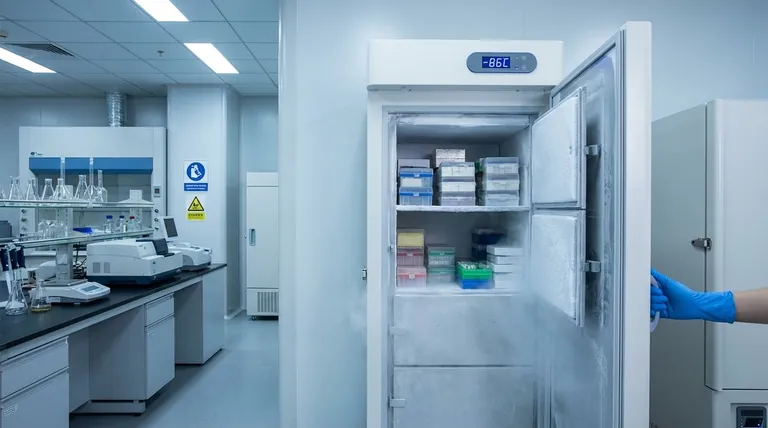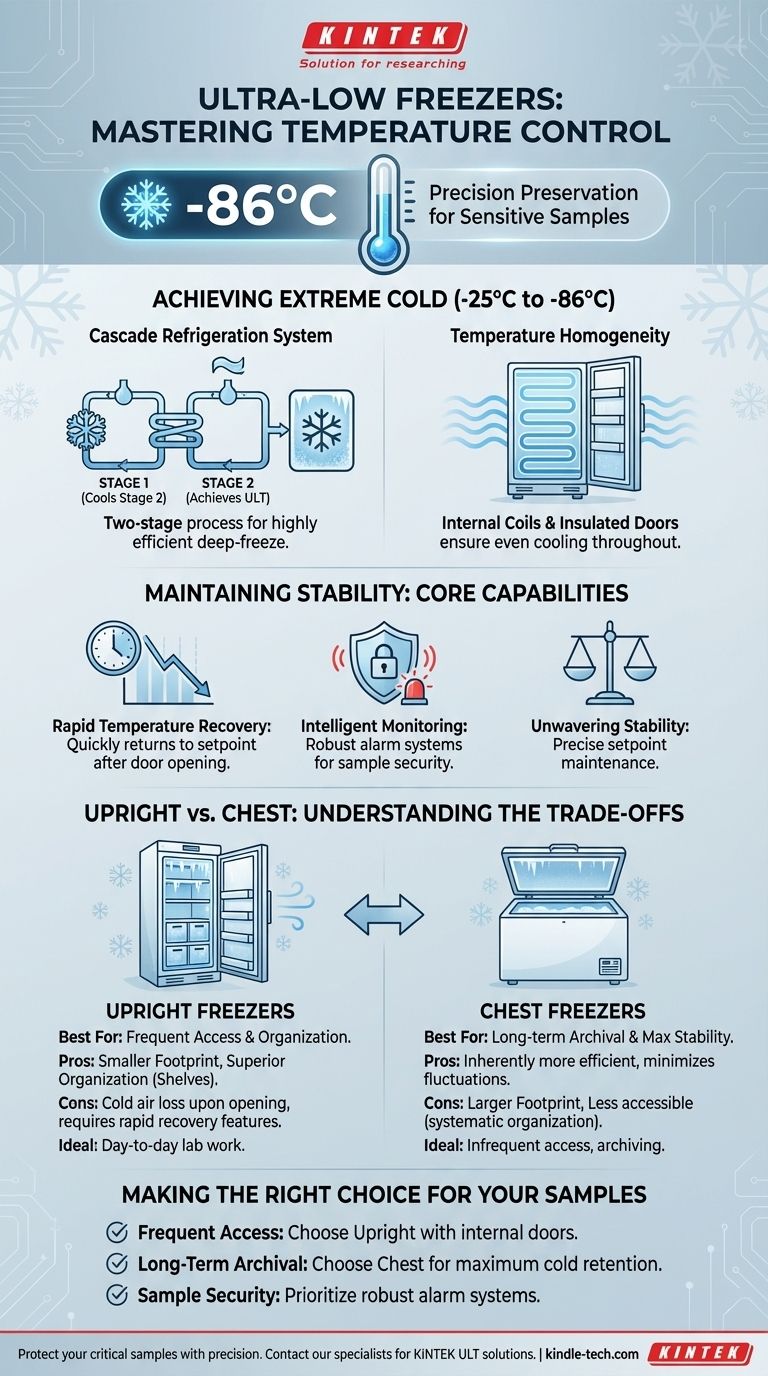At its core, an ultra-low temperature (ULT) freezer's primary capability is to achieve and precisely maintain temperatures as low as -86°C. This extreme cold is critical for the long-term preservation of sensitive biological samples, enzymes, and other materials. Unlike standard low-temperature freezers that operate in the -25°C to -40°C range, ULT freezers are defined by their ability to provide a highly stable and uniform deep-freeze environment.
The true measure of a ULT freezer is not just its ability to reach an extreme temperature, but its capacity to maintain that temperature with unwavering stability. This is accomplished through a sophisticated interplay of refrigeration mechanics, structural design, and intelligent monitoring systems.

How ULT Freezers Achieve and Maintain Extreme Cold
The ability to hold a precise setpoint like -80°C relies on more than just raw power. It is a function of the core refrigeration technology and design features that ensure temperature uniformity and rapid recovery from disturbances.
The Cascade Refrigeration System
At the heart of most ULT freezers is a cascade refrigeration system. This design uses two separate refrigeration circuits that work in tandem.
The first circuit cools the second, allowing the second circuit to use a refrigerant gas that can achieve much lower temperatures than a single-compressor system could alone. This two-stage process is highly efficient at reaching and holding temperatures in the -86°C range.
Ensuring Temperature Homogeneity
Achieving a low temperature is meaningless if it varies throughout the chamber. ULT freezers use specific features to ensure temperature homogeneity, meaning the temperature is consistent in every corner.
This is often accomplished with internal steel plate heat exchangers or coils that line the chamber walls, ensuring even cooling. Furthermore, most upright models feature insulated internal doors for each shelf, creating compartments that prevent widespread temperature loss when the main door is opened.
Rapid Temperature Recovery
In a working lab, a freezer door is opened frequently. A key aspect of temperature control is how quickly the freezer can return to its setpoint after a door opening.
This capability, often called temperature pull-down or recovery, is a critical performance metric. A robust cascade system and efficient internal air circulation allow the unit to quickly compensate for the introduction of warmer ambient air, protecting samples from thermal stress.
Understanding the Trade-offs: Upright vs. Chest Freezers
The physical design of the freezer has a direct impact on its temperature control characteristics and usability. The choice between an upright and chest model is a fundamental trade-off between accessibility and thermal efficiency.
The Case for Upright Freezers
Upright freezers are the most common choice in laboratory settings due to their smaller footprint and superior organization. Shelving allows for easy categorization and access to frequently used samples.
However, their primary drawback is physics: when the door is opened, the cold, dense air inside rushes out and is replaced by warmer, moist ambient air. This makes features like multiple internal doors and rapid temperature recovery systems absolutely essential for maintaining stability.
The Case for Chest Freezers
Chest freezers are inherently more efficient at maintaining temperature. Because the lid opens from the top, the cold, dense air tends to stay inside the freezer cavity, minimizing temperature fluctuations during access.
This makes them ideal for long-term archival storage where samples are accessed infrequently. The trade-off is accessibility, as reaching items at the bottom can be difficult and requires more systematic organization.
Making the Right Choice for Your Samples
The ideal freezer configuration depends directly on how you plan to interact with your stored materials.
- If your primary focus is frequent sample access and organization: An upright ULT freezer with multiple internal doors is the most practical choice for day-to-day lab work.
- If your primary focus is long-term archival and maximum stability: A chest freezer is inherently better at retaining cold and is superior for samples that will be accessed infrequently.
- If your primary focus is sample security and compliance: Prioritize a model with robust, user-configurable visual and audible alarm systems to ensure you are immediately alerted to any temperature deviation.
Ultimately, selecting the right freezer is about matching its specific temperature control features to the unique preservation needs of your work.
Summary Table:
| Feature | Upright ULT Freezer | Chest ULT Freezer |
|---|---|---|
| Best For | Frequent sample access & organization | Long-term archival storage & maximum stability |
| Temperature Stability | Good, with rapid recovery features | Excellent, due to inherent design |
| Accessibility | High, with shelving and internal doors | Lower, requires systematic organization |
| Footprint | Smaller | Larger |
Protect your critical samples with precision. Choosing the right ultra-low freezer is essential for the integrity of your biological materials, enzymes, and reagents. KINTEK specializes in laboratory equipment, including a range of ULT freezers designed for superior temperature control and sample security. Let our experts help you select the ideal model—whether an upright for daily use or a chest for archiving—to ensure your research is preserved under optimal conditions.
Contact our lab equipment specialists today for a personalized consultation.
Visual Guide

Related Products
- 58L Precision Laboratory Ultra Low Temperature Upright Freezer for Critical Sample Storage
- 508L Advanced Vertical Ultra Low Temperature Freezer for Critical Laboratory Storage
- 708L Ultra Low Temperature Freezer High Performance Laboratory Freezer
- 208L Advanced Precision Laboratory Ultra Low Temperature Freezer for Cold Storage
- 608L Essential Laboratory Ultra Low Temperature Freezer For Critical Sample Preservation
People Also Ask
- What are the key construction features of ultra low temperature freezers? Essential Design for Protecting Critical Samples
- What are the common designs of ultra-low temperature freezers? Upright vs. Chest Models for Your Lab
- What factors should be considered when selecting an ultra-low temperature freezer? Ensure Sample Integrity and Long-Term Value
- How do Ultra-Low Temperature freezers ensure the integrity of microbiological samples? Maintain Stability for Critical Research
- What temperature range do Ultra-Low Temperature (ULT) freezers typically maintain? Preserve Your Samples from -40°C to -86°C



















